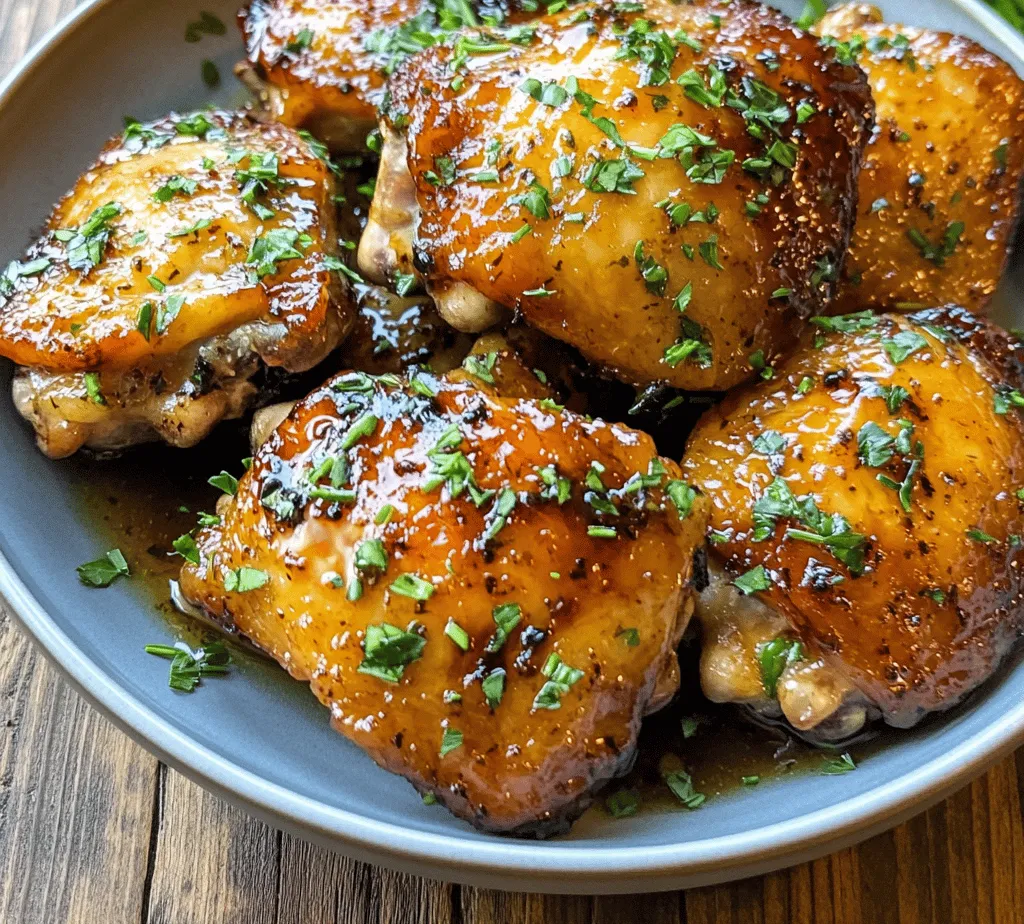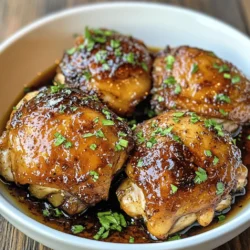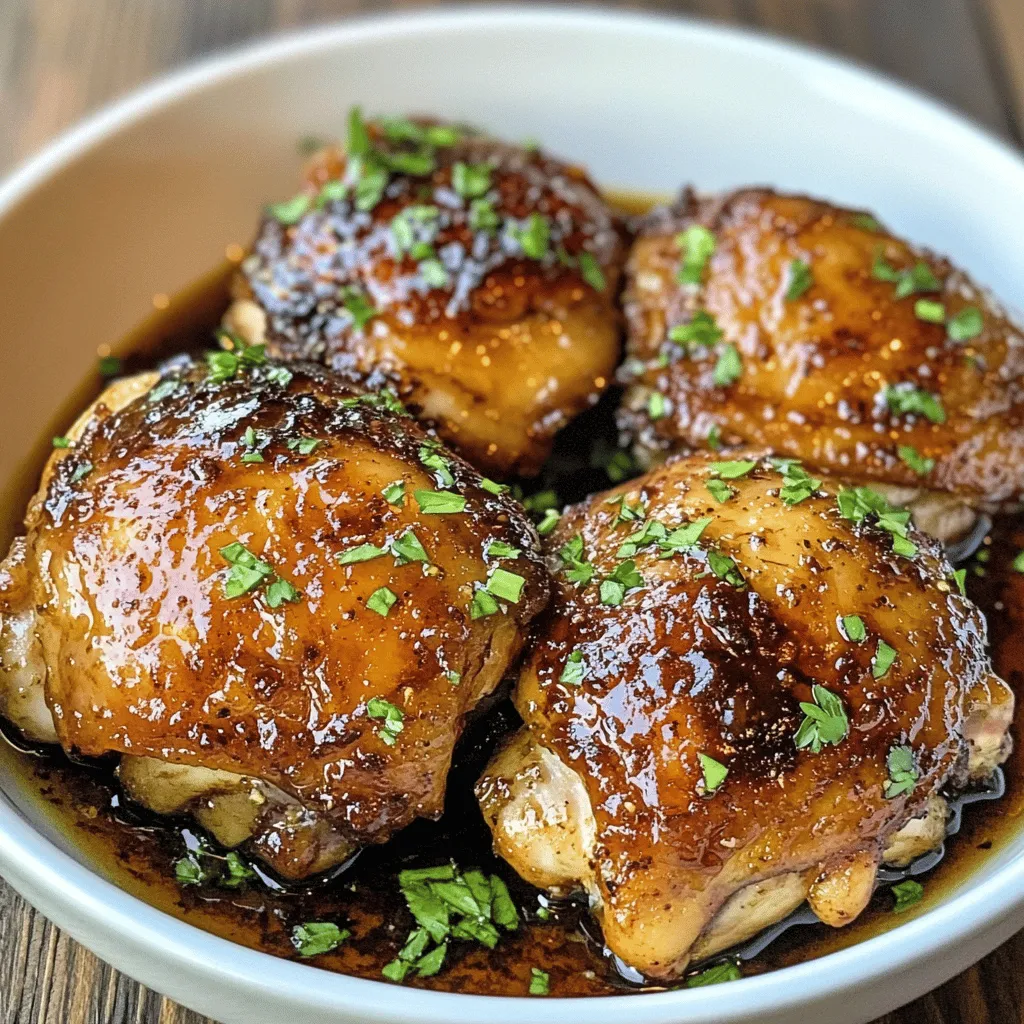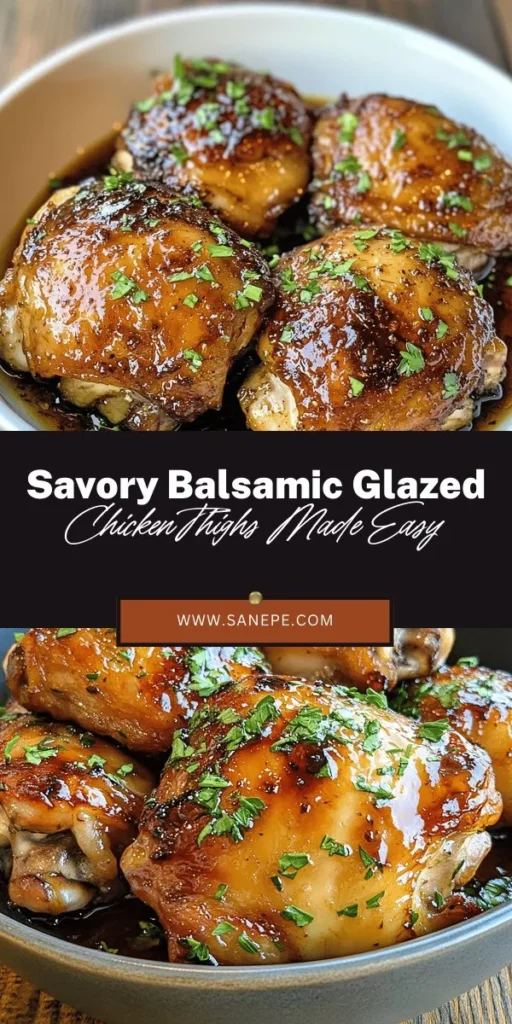Introduction
If you’re looking for a dish that beautifully balances savory and sweet flavors while remaining easy to prepare, look no further than balsamic glazed chicken thighs. This delectable recipe showcases tender, juicy chicken thighs enveloped in a rich balsamic glaze that is both satisfying and elegant. The dish is perfect for weeknight dinners or special occasions, making it a versatile option for any home cook.
The key to the appeal of balsamic glazed chicken thighs lies in the harmonious blend of ingredients. The sweetness of balsamic vinegar pairs perfectly with the savory chicken, while honey adds an additional layer of complexity. With a touch of Dijon mustard and the aromatic qualities of garlic and herbs, this dish is a sensory delight that will leave your taste buds dancing.
Moreover, chicken thighs are not only delicious; they also come with a host of health benefits. Rich in protein, vitamins, and minerals, chicken thighs can be a great addition to a balanced diet. When paired with the tangy goodness of balsamic vinegar, which is lower in calories and packed with antioxidants, you have a dish that is as nourishing as it is flavorful.
Understanding the Ingredients
To achieve the perfect balsamic glazed chicken thighs, it’s crucial to understand the role each ingredient plays in elevating the dish’s overall flavor profile. Let’s break down the essential ingredients and their contributions:
Chicken Thighs
Opting for bone-in, skin-on chicken thighs is essential for maximizing flavor and moisture. The skin crisps up beautifully during cooking, creating a delightful contrast to the tender meat beneath. The bones also impart additional flavor to the dish, making each bite succulent and satisfying. Chicken thighs are generally more forgiving than chicken breasts when it comes to cooking time, making them an ideal choice for home cooks of all skill levels.
Balsamic Vinegar
Balsamic vinegar is the star of this recipe, offering a complex flavor profile that is both tangy and slightly sweet. It adds depth to the glaze and helps to tenderize the chicken during the marinating process. Beyond flavor, balsamic vinegar is known for its health benefits, including its ability to regulate blood sugar levels and its antioxidant properties, making it a smart choice for any meal.
Honey
Honey serves as a natural sweetener in the balsamic glaze, balancing the acidity of the vinegar. It not only enhances the flavor but also helps create a beautiful caramelized crust on the chicken when cooked. Honey is also known for its antibacterial properties and can contribute to a healthier diet when used in moderation.
Dijon Mustard
Adding Dijon mustard to the marinade introduces a tangy depth that complements the sweetness of the honey and the acidity of the balsamic vinegar. Its unique flavor enhances the overall taste of the dish, making the glaze more complex and enjoyable. Plus, Dijon mustard is a low-calorie condiment that can provide a flavorful punch without unnecessary calories.
Garlic
Garlic is another essential ingredient that brings an aromatic quality to the dish. Not only does it add flavor, but it also boasts numerous health benefits, including anti-inflammatory properties and support for heart health. The garlic will infuse the chicken with its robust flavor, making each bite more appetizing.
Herbs (Thyme and Rosemary)
Fresh herbs like thyme and rosemary elevate the flavor profile of the balsamic glaze and add a delightful aroma to the dish. Thyme offers a subtle earthy flavor, while rosemary provides a fragrant, pine-like essence. Both herbs pair beautifully with chicken, enhancing its natural flavors and making the dish more aromatic and inviting.
Olive Oil
Olive oil plays a crucial role in this recipe by providing fat that helps to sear the chicken thighs, ensuring they develop a golden-brown crust. It also contributes to the overall mouthfeel of the dish, making it richer and more satisfying. Additionally, olive oil is a healthy fat that can promote heart health, making it a staple ingredient in many recipes.
Fresh Parsley
Lastly, fresh parsley serves as a garnish that adds a pop of color and a fresh flavor to the dish. While it may seem like a minor detail, a sprinkle of parsley can brighten the dish and enhance its visual appeal. Moreover, parsley is rich in vitamins and minerals, further boosting the nutritional value of the meal.
Marinating the Chicken
Marination is a crucial step in preparing balsamic glazed chicken thighs, as it enhances the flavor and tenderness of the meat. By allowing the chicken to soak in the marinade, you ensure that every bite is infused with the rich, tangy sweetness of the balsamic glaze.
Preparing the Marinade
To prepare the marinade, you’ll need a mixing bowl or a resealable plastic bag. Combine the balsamic vinegar, honey, Dijon mustard, minced garlic, and a drizzle of olive oil. Whisk or shake the mixture until all the ingredients are well incorporated. This marinade not only coats the chicken but also penetrates the meat, infusing it with flavor.
Marinating Duration
For optimal flavor absorption, it’s best to marinate the chicken thighs for at least 30 minutes. However, for even more intense flavor, consider marinating them for several hours or overnight in the refrigerator. If time is tight, even a quick 30-minute soak will enhance the taste significantly. Just be sure to discard any leftover marinade that has come into contact with raw chicken to prevent cross-contamination.
Preparing the Chicken Thighs
Once your chicken thighs have marinated to perfection, it’s time to prepare them for cooking. The first step is to preheat your oven, which is crucial for achieving that perfect caramelization and juicy texture.
Preheating the Oven
Preheat your oven to 400°F (200°C). This temperature is ideal for roasting chicken thighs, allowing the skin to crisp up while ensuring the meat cooks through without drying out. A hot oven creates an environment conducive to browning, which enhances the flavor and texture of the chicken.
With the introduction and initial steps covered, you are well on your way to creating a memorable meal of balsamic glazed chicken thighs. The balance of flavors and the health benefits of the ingredients make this dish a standout choice for any occasion. In the following sections, we will dive deeper into the cooking process to ensure that your dish turns out perfectly every time.

Techniques for Searing Chicken Thighs to Achieve the Perfect Golden Crust
Searing chicken thighs is a crucial step in achieving a delicious, golden crust that enhances both the flavor and texture of the dish. To start, ensure that your chicken thighs are thoroughly dried with paper towels. Moisture is the enemy of a good sear, so removing excess moisture helps to create that coveted crust.
Heat a tablespoon of oil — preferably olive or vegetable oil — in a large, heavy-bottomed skillet over medium-high heat. Once the oil shimmers, carefully place the chicken thighs in the skillet, skin side down. Do not overcrowd the pan; if necessary, work in batches to maintain the cooking temperature. Allow the chicken to sear undisturbed for about 7-8 minutes. This will allow the skin to crisp up beautifully and develop deep flavors.
For an even more flavorful crust, consider seasoning the chicken thighs with salt and pepper prior to searing. Once the skin is golden brown and releases easily from the pan, flip the thighs over and sear the other side for an additional 4-5 minutes. The goal is to achieve a beautifully browned exterior, which will contribute to the overall flavor of the dish once the balsamic glaze is added.
Explanation of the Cooking Process and the Importance of Temperature Control
Temperature control is vital throughout the cooking process. Searing at the right heat ensures that the skin crisps up without burning, while maintaining a juicy interior. After searing, the thighs are transferred to the oven where they finish cooking and absorb the flavors of the balsamic glaze.
When transitioning from stovetop to oven, preheat your oven to 400°F (200°C). This temperature is ideal for roasting chicken thighs, allowing them to cook through while the exterior caramelizes beautifully. Using an oven thermometer can help maintain the accuracy of your cooking temperature, ensuring consistent results each time.
Creating the Balsamic Glaze
The balsamic glaze is a highlight of this recipe, as it adds a rich, tangy sweetness that complements the savory chicken thighs.
The Science Behind the Reduction of the Marinade During Roasting
When the marinade is reduced during roasting, the flavors concentrate, creating a thick, syrupy glaze that clings to the chicken. The process of reduction involves simmering the marinade until the water content evaporates, leaving behind a potent mixture of balsamic vinegar, honey, garlic, and any other ingredients you’ve chosen to include. The high sugar content in honey also aids in caramelization, resulting in a beautiful glaze.
Step-by-Step Instructions for Glazing the Chicken Thighs
1. After searing the chicken thighs on both sides, remove them from the skillet and set them aside on a clean plate.
2. In the same skillet, add the reserved marinade that you set aside before cooking. Bring it to a gentle simmer, scraping up any browned bits from the bottom of the pan. This will infuse even more flavor into the glaze.
3. Allow the marinade to simmer for about 5-7 minutes until it thickens and reduces by about half.
4. Once thickened, return the seared chicken thighs to the skillet, spooning the glaze over them to ensure they are well coated.
5. Transfer the skillet to the preheated oven and roast for 25-30 minutes, occasionally basting with the glaze, until the chicken is fully cooked and the skin is glossy.
Importance of Using Reserved Marinade for Flavor Enhancement
Using reserved marinade is essential for enhancing the flavor profile of the chicken thighs. The marinade not only adds depth to the dish but also helps to keep the chicken moist during roasting. Be sure to reserve a portion of the marinade that hasn’t come into contact with raw chicken to avoid cross-contamination. This step is crucial for food safety and for achieving that perfect flavor balance.
Roasting the Chicken Thighs
Now that the chicken thighs are glazed, it’s time to roast them to perfection.
Detailed Instructions for Transferring to Oven and Roasting Times
1. Preheat your oven to 400°F (200°C).
2. Once your chicken thighs are glazed, transfer the skillet to the oven carefully. If your skillet isn’t oven-safe, transfer the chicken thighs and glaze to a baking dish.
3. Roast the chicken for 25-30 minutes, or until the internal temperature reaches 165°F (74°C).
How to Check for Doneness (Internal Temperature Guide)
The best way to ensure chicken thighs are fully cooked is by using an instant-read thermometer. Insert the thermometer into the thickest part of the thigh, avoiding bone for an accurate reading. Once the temperature reads 165°F (74°C), the chicken is safe to eat.
Discussing the Role of Resting the Chicken Post-Roasting
After removing the chicken from the oven, allow it to rest for about 5-10 minutes before serving. Resting is a vital step, as it allows the juices within the chicken to redistribute. This results in a juicier and more flavorful bite. Cover the chicken loosely with foil during this resting period to keep it warm.
Serving Suggestions
To make the most of your balsamic glazed chicken thighs, consider pairing them with complementary side dishes that enhance the overall dining experience.
Ideas for Side Dishes that Complement Balsamic Glazed Chicken Thighs
1. Roasted Vegetables: Seasonal vegetables such as Brussels sprouts, carrots, and sweet potatoes roasted with olive oil and herbs make a nutritious and colorful side dish.
2. Rice or Quinoa: A bed of fluffy rice or nutty quinoa can soak up the flavorful glaze, creating a delightful combination.
3. Salads: A fresh arugula or spinach salad with sliced almonds, feta cheese, and a light vinaigrette pairs beautifully with the rich flavors of the chicken.
Presentation Tips for an Attractive Dish
To present your balsamic glazed chicken thighs beautifully, arrange the chicken on a large serving platter. Drizzle any remaining glaze over the top and garnish with freshly chopped herbs such as parsley or basil for a pop of color. Serve with your chosen sides arranged thoughtfully around the chicken for an appealing display.
Pairing Recommendations for Drinks (Wines, Juices)
When it comes to drink pairings, opt for a medium-bodied red wine such as Pinot Noir or a fruity white like Sauvignon Blanc to complement the tangy notes of the balsamic glaze. If you prefer non-alcoholic options, a sparkling apple cider or a refreshing lemonade can provide a delightful contrast to the savory chicken.
Nutritional Benefits
Balsamic glazed chicken thighs not only offer a delicious meal but also present several nutritional benefits.
Overview of the Nutritional Content of the Chicken Thighs
Chicken thighs are a great source of protein, providing essential amino acids necessary for muscle repair and growth. They are also rich in vitamins such as B6 and B12, which support energy metabolism and brain health.
Benefits of Balsamic Vinegar and Honey in a Balanced Diet
Balsamic vinegar is known for its antioxidant properties and potential health benefits, including improved digestion and blood sugar regulation. Honey, a natural sweetener, offers various antioxidants and has been used for its anti-inflammatory properties. Together, they create a delicious glaze that contributes to a balanced diet.
Discussion on Portion Control and Serving Sizes
When enjoying balsamic glazed chicken thighs, it’s important to consider portion control. A serving size of one thigh, paired with a side of vegetables and whole grains, can make for a satisfying and nutritious meal. Be attentive to your body’s hunger cues, and remember that balance is key in any diet.
Conclusion
The experience of making and enjoying balsamic glazed chicken thighs is one that combines simplicity with elegance. This recipe not only delights the palate but also showcases the art of cooking with fresh ingredients and thoughtful techniques. From the perfectly seared exterior to the rich, glossy glaze, every bite is a testament to the beauty of home cooking.
Whether you’re preparing a weeknight dinner or hosting a family gathering, this dish is sure to impress. With straightforward steps and easily accessible ingredients, even novice cooks can create a restaurant-quality meal at home.
Encourage your loved ones to join in on the cooking process, turning meal preparation into a fun and memorable experience. So go ahead, gather your ingredients, and try this balsamic glazed chicken thighs recipe — your taste buds will thank you!


